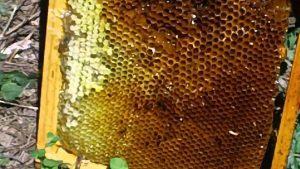Small hive beetle, a beekeeping pest, is endemic to sub-Saharan Africa. However, their range has gradually spread over a large area, including North America, Central America, Australia, the Philippines, and even Italy. From their name itself, one could determine how notorious it is in destroying honey bee colonies, damaging combs, alongcol3 stored honey and the pollen.
Size: Males – 5.5 mm (0.21 inches); Females -5.7 mm (0.22 inches)
Color: The adults have a light brown body at the beginning that gradually gets darker or blacker as they mature.
Other Characteristic Features: They have an oval-shaped body and club-like antennae.
They have a cream body reaching about 11 mm (0.43 inches) when fully grown. They resemble the wax moth’s larva though smaller in size. They have a large head, and close to it lie three pair prolegs. Several protuberances also cover their body. They mostly feed on honey and pollen, maturing in 10 to 16 days.
When the larva is prepared to enter the pupation phase, they burrow in the soil close to the beehive. The pupae have a bluish-tan body with a similar size as that of the adults. When matured, the pupas also have adult-like appendages, though not developed completely. The pupation period occurs for 3 to 4 weeks. In a week from their emergence as adults, the females start mating and laying eggs.
They are tiny and pearly white and take about 2 to 3 days to hatch. The eggs are mostly laid within the hive in crevices or cracks.
| Adult lifespan | 6 months |
| Duration of larval stage | Not recorded |
| Distribution | Parts of North America (California, Georgia, Connecticut, Kansas, Oklahoma, Ohio, New Jersey, Pennsylvania, Texas, Tennessee, Virginia; some portions of Canada; Australia, Philippines, and Italy |
| Habitat | Near beehives |
| Common Predators | Wasps, bats, birds |
| Seasons active from | May-August |
| Diet of larvae and adults | Larvae: Pollen, honey, and honey bee brood Adults : Mostly honey |
The small hive beetle larvae cause major damage as they tunnel through, destroying the honeycomb’s cappings alongcol3 the comb itself. Because of the larval intrusion in the combs, the honey gets frothy and fermented, developing an orange color and eventually getting decayed.
As per beekeepers, a severe infestation could lead healthy colonies to collapse. Despite the damage they cause, in South Africa, these beetles are concol3red a secondary pest.
However, in different parts of the United States like Florida and South Carolina, the small hive beetle is infamous for the damage it does to the hives, resulting in heavy losses.

Image Source: lh3.googleusercontent.com, upload.wikimedia.org, catalog.extension.oregonstate.edu, i.ytimg.com, s3.amazonaws.com, static.producer.com
Small hive beetle, a beekeeping pest, is endemic to sub-Saharan Africa. However, their range has gradually spread over a large area, including North America, Central America, Australia, the Philippines, and even Italy. From their name itself, one could determine how notorious it is in destroying honey bee colonies, damaging combs, alongcol3 stored honey and the pollen.
Size: Males – 5.5 mm (0.21 inches); Females -5.7 mm (0.22 inches)
Color: The adults have a light brown body at the beginning that gradually gets darker or blacker as they mature.
Other Characteristic Features: They have an oval-shaped body and club-like antennae.
They have a cream body reaching about 11 mm (0.43 inches) when fully grown. They resemble the wax moth’s larva though smaller in size. They have a large head, and close to it lie three pair prolegs. Several protuberances also cover their body. They mostly feed on honey and pollen, maturing in 10 to 16 days.
When the larva is prepared to enter the pupation phase, they burrow in the soil close to the beehive. The pupae have a bluish-tan body with a similar size as that of the adults. When matured, the pupas also have adult-like appendages, though not developed completely. The pupation period occurs for 3 to 4 weeks. In a week from their emergence as adults, the females start mating and laying eggs.
They are tiny and pearly white and take about 2 to 3 days to hatch. The eggs are mostly laid within the hive in crevices or cracks.
| Adult lifespan | 6 months |
| Duration of larval stage | Not recorded |
| Distribution | Parts of North America (California, Georgia, Connecticut, Kansas, Oklahoma, Ohio, New Jersey, Pennsylvania, Texas, Tennessee, Virginia; some portions of Canada; Australia, Philippines, and Italy |
| Habitat | Near beehives |
| Common Predators | Wasps, bats, birds |
| Seasons active from | May-August |
| Diet of larvae and adults | Larvae: Pollen, honey, and honey bee brood Adults : Mostly honey |
The small hive beetle larvae cause major damage as they tunnel through, destroying the honeycomb’s cappings alongcol3 the comb itself. Because of the larval intrusion in the combs, the honey gets frothy and fermented, developing an orange color and eventually getting decayed.
As per beekeepers, a severe infestation could lead healthy colonies to collapse. Despite the damage they cause, in South Africa, these beetles are concol3red a secondary pest.
However, in different parts of the United States like Florida and South Carolina, the small hive beetle is infamous for the damage it does to the hives, resulting in heavy losses.

Image Source: lh3.googleusercontent.com, upload.wikimedia.org, catalog.extension.oregonstate.edu, i.ytimg.com, s3.amazonaws.com, static.producer.com